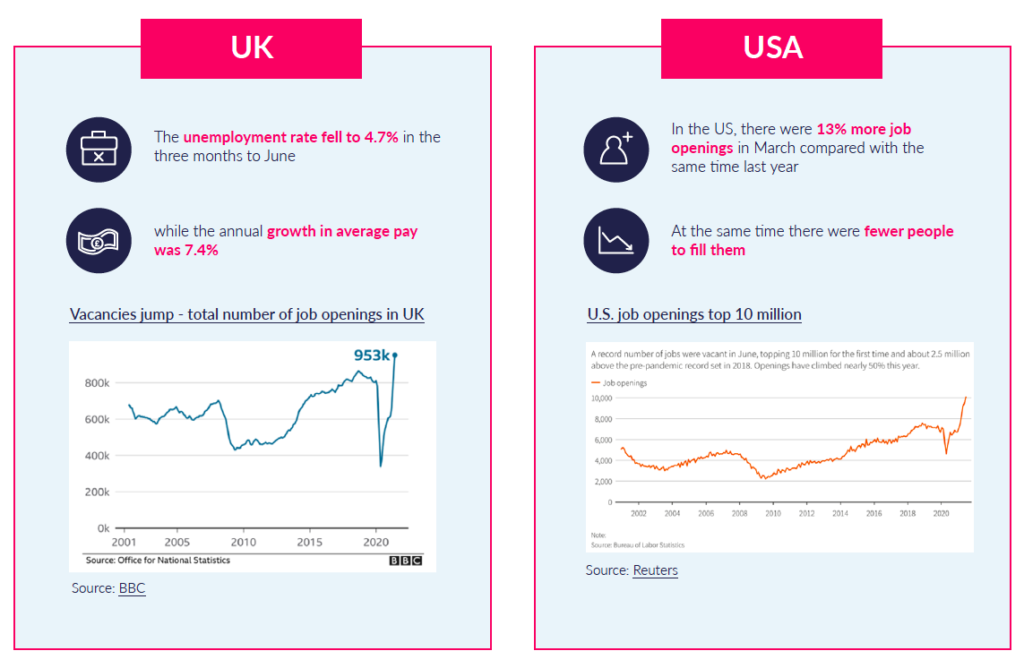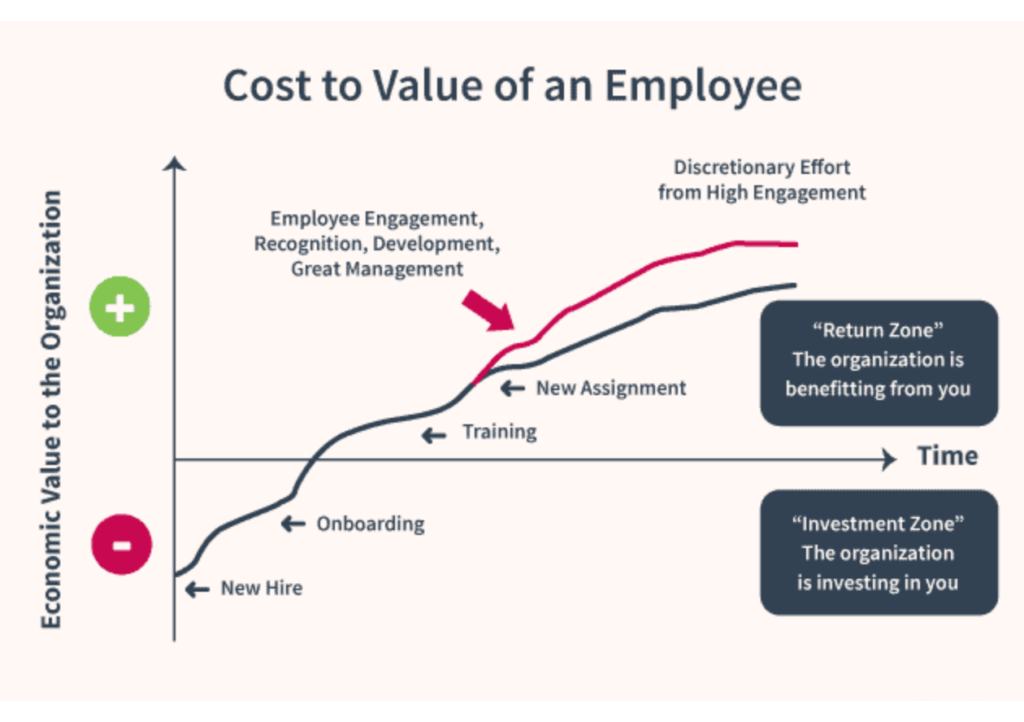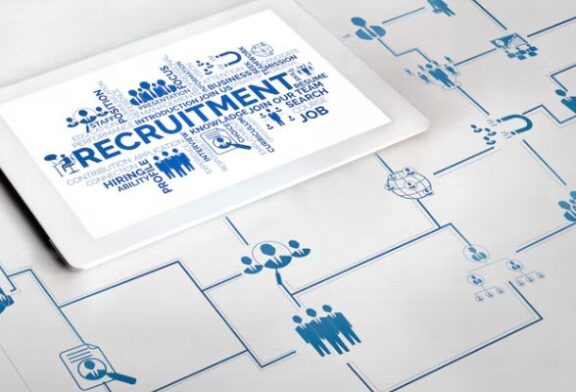Introduction: The war for talent
Whilst the past 15 months were mainly about survival and for many, ensuring that their company remained operational, we now see a surge in job vacancies both in the UK and the US.
This surge brings with it changing employee expectations that require companies and HR professionals to adjust their focus too. We are heading towards a talent war and keeping critical skills. Our own global research highlights an increase in the number of employees who feel that their organisation no longer meets their changing personal needs.
With 41% of employees thinking the culture of their organization has deteriorated since the pandemic. Culture, communication, and churn have emerged as the three biggest challenges for businesses. 30% of employees are planning on leaving their roles post-pandemic, and 42% of HR managers noticing an increase in turnover.
Increased staff turnover means more emphasis on recruitment and getting the right fit for the organization. Minimising the chances for hiring the wrong person will not only reduce employee churn – a staggering 80% of employee turnover happens because of a bad hire – but will also save on costs associated with recruitment.
Why Do Bad Hires Happen?
The US department of labour suggests the cost of a bad hire is up to 30% of the employee’s first-year earnings. McKinsey also notes that hiring a top performer over an average performer improves productivity and profit by 67%. But how do so many unsuitable employees slip under the radar? Research identified the following as the most common reasons for not getting it right:
1. Lack of hiring experience
Assessing an applicant’s CV is only one of the first crucial steps you’ll take when choosing who to bring into your team. Companies also need to dive deeper with exceptional interviewing skills, a critical eye, and the ability to pinpoint shared values. Unfortunately, it’s common for inexperienced hiring managers to get caught up in how good a candidate looks on paper.
2. Misjudging character
It’s easy to assume a candidate is a good fit for your team because they seem pleasant in the interview. However, it’s important to remember that the person you meet in the interview isn’t always who you’ll get on your team. You’ll need to ensure the motives, values, and working styles of the person you’re hiring are aligned with your team.
3. Focusing on Cutting Costs
When budget restrictions are high, it’s tempting to choose a candidate based on low salary expectations or saving on money spent on advertising. However, compromising on quality to save costs in the short term usually leads to more expenses in the long run. The negative impact of a bad hire on productivity and the costs associated with replacing them can quickly add up.
4. Rushing into desperate decisions
Often, companies don’t have time to wait around for the best candidate to appear out of thin air. If you need someone urgently, you might be keen to jump in without doing your homework. Alternatively, you may find someone who seems great and act fast to avoid losing them. Taking your time is crucial to ensuring you don’t make any risky snap judgements.
5. Weak employer brand
Ambiguity around your unique value proposition or having a weak mission statement can all have a direct impact on your culture. It isn’t easy to know who’s going to be a good fit for your team if it is unclear what to match them to. Having a strong employer brand and understanding of your company culture ensures you have the information required to search for the right person during the recruitment process.

Other common reasons for choosing a bad hire
Aside from the reasons mentioned above, studies have identified other reasons for getting it wrong:
- The candidate lied about qualifications
- They wanted to take a chance on a nice person
- They thought the client could learn crucial skills quickly
- The search for qualified candidates was too high
- Skills on a CV outweighed the importance of the right attitude
- Lack of tools for a background check and search
The definition of a bad hire might vary from company to company, but usually, it boils down to not being able to produce quality work, not being able to work well with others, lacking the right attitude or issues with their attendance.
How Much Does a Bad Hire Cost?
The cost of a bad hire goes far beyond monetary issues. Everything from your team’s performance to your ability to attract new talent can suffer as the result of just one bad choice. However, it’s worth noting that poor hiring strategies have financial repercussions too.
According to a CareerBuilder survey, a bad hire in the US will usually cost around $52,000, while a bad hire in the UK costs around £50,000. The more crucial the employee is to your business and its operations, the more money you risk wasting on replacing that hire, training a new employee, and even fixing the mistakes the last staff member made.
Glassdoor notes that the average employer spends around £3,000 in the UK and around 27.5 days to hire a new staff member. On top of that, there are a host of additional costs to consider, like background checks, using recruitment technology, and conducting pre-hire assessments.
Alternatively, if we look at the Return on Investment from hiring true talent, we begin to see just how valuable the right choice can be. According to Deloitte, the average ROI for a good hire is around 1.32, which means that you earn $1.32 for every $1 spent. In certain industries, like food, oil, and gas, or pharmaceuticals, this ROI increases to over $2 for every $1 spent.
Source: Josh Bersin, Employee Retention Now a Big Issue: Why the Tide has Turned
The intangible costs of getting it wrong:
As mentioned above, the financial costs of a bad hire are just the beginning.
While the expense of a bad hire can be substantial, it’s the additional consequences that often have the longest-lasting impact on your workplace. For instance, some of the costs of a bad hire include:
- Wasted time: Searching for the perfect employee takes a lot of time and effort. When you choose the wrong hire, you’re wasting not only the time required to find the first employee, but the time necessary to find their replacement.
- Time and effort invested in the onboarding process: Most new employees have to go through some type of an onboarding process. This often includes background checks (at a cost), training staff on how to use new tools and systems or product training. Whilst embedding new hires and they learn, they are naturally less effective.
- Lost productivity: A poor hire has a direct impact on the rest of your team. Someone with a bad attitude can impact on staff morale. A person who doesn’t get work done according to company standards will have other team members picking up after them, reducing the performance rates of the rest of your team.
- Diminished engagement: When employees see you hiring and firing an employee in a short space of time, this leads to concern about their place in your business. Your employees may question how committed they should be.
- Tarnished employer brand: Your reputation as an employer begins to suffer when you have a higher turnover. People begin to question if you can keep hold of an employee.
How Do You Prevent a Bad Hire?
Preventing a bad hire means creating a solid strategy for seeking out and recruiting new talent. It starts with considering the following key points:
- Start with your unique value proposition: As the Harvard Business Review puts it “Culture fit is the glue that holds an organization together”. So before, you can start measuring candidates’ culture fit, you need to define and articulate the organization’s culture – its values, goals, mission statement and practices.
- Focus on person – organization (culture) fit: Cultural fit is the possibility that someone will reflect and/or be able to adapt to the core beliefs, attitudes, and behaviours that make up your organization. Competency based recruitment is an effective approach you can adopt for ensuring a good fit.
- Use data and analytics: Analysing data on employee engagement, sentiment and performance can pinpoint certain trends and unengaged or underperforming employees to flag up potential bad hires. You can use this data and tailor your recruitment process accordingly.
- Pay attention to your employer brand and employee experiences: An appealing employer brand will put you in a desirable position when it comes to attracting top talent and recruitment. Employee Experience means creating a strong onboarding program, giving your employees the tools to be their best and produce the best work, focusing on setting clear goals and targets, and giving employees development, career growth, and on-the-job learning.
- Keep improving: Commit to constantly improving your culture and your hiring process. Collect feedback from employees to see what is working and course correct if needed. As mentioned earlier companies that strive for a person – organization (culture) fit are less like to have issues with recruitment.
The bottom line
Getting recruitment right has a lot of tangible benefits, such as reduced costs, and intangible benefits like time and effort saved, increased productivity and employee morale just to mention a few. However, there are many causes of bad hires, culture and organizational values being some of them. So, it is important to invest time, energy and money in building your organizational culture because they are the foundation that underpins all the other activities such as recruitment, attitude to investments and training and giving employees the confidence to make the right decisions.







